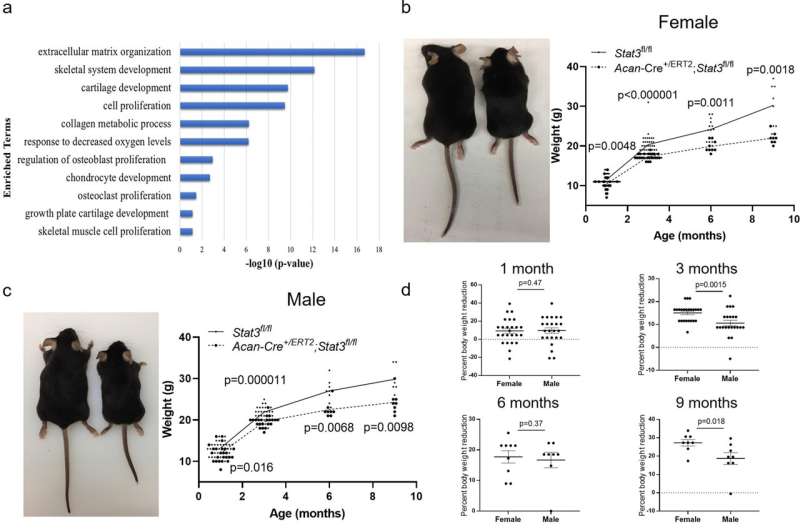Fig. 1: STAT3 regulates anabolic genes in human fetal chondrocytes and body size in mice. a Altered gene expression in human fetal chondrocytes after knockdown of STAT3 by shRNA in vitro as determined by bulk RNA-Seq and GO analysis; n = 3. Postnatal deletion of Stat3 in chondrocytes via Acan-Cre+/ERT2 in vivo decreases body weight and size of female (b) and male (c) mice; n ≥ 7 for each sex and genotype per timepoint. Images of 6 month old mice are shown. d Reductions in body weight in Stat3 mutants compared to WT littermates were greater in female than in male mice. e Stat3 protein localized to the resting and proliferative zones of the growth plate at 1 month in WT mice. f Stat3 and pStat3 levels were higher in WT female mice as compared to WT male mice (n = 8). Scale bars = 50 µm. Credit: DOI: 10.1038/s42003-021-02944-y
The IL-6 family of proteins has a bad reputation: it can promote inflammation, arthritis, autoimmune disease and even cancer. However, a new USC-led study published in Communications Biology reveals the importance of IL-6 and associated genes for maintaining and regenerating cartilage in both the joints and in the growth plates that enable skeletal growth in children.
"We show, for the first time, that the IL-6 family, previously almost exclusively associated in the musculoskeletal field with arthritis, bone and muscle loss, and other chronic inflammatory diseases, is required for the maintenance of skeletal stem and progenitor cells, and for the healthy growth and function of the joints and spine," said the study's corresponding author Denis Evseenko, who is the J. Harold and Edna LaBriola Chair in Genetic Orthopedic Research, and an associate professor of orthopedic surgery, and stem cell biology and regenerative medicine at USC. "Our study establishes a link between inflammation and regeneration, and may explain why stem and progenitors are exhausted in chronic inflammation."
In the study, first author Nancy Q. Liu from USC and her colleagues took a close look at a key gene activated by IL-6: STAT3. In both lab-grown human cells and in mice, the scientists demonstrated that STAT3 is critical for the proliferation, survival, maturation and regeneration of cartilage-forming cells in the joints and growth plates. When the gene ceased to function, cartilage-forming cells became increasingly dysfunctional over time, resulting in smaller body size, prematurely fused growth plates, underdeveloped skeletons and mildly degenerated joint cartilage.
Mice experienced the same issues when they lacked a protein called glycoprotein 130 (gp130), which all IL-6 proteins use to activate Stat3. Deactivating another gene Lifr, which encodes a protein that works with gp130 to recognize one of the IL-6 proteins called Lif, produced similar but milder skeletal and cartilage changes.
In mice lacking gp130, the scientists could restore normal growth plates by over-activating Stat3—although this also caused an overgrowth of cartilage that led to other skeletal abnormalities.
Interestingly, the researchers noted significant sex-related differences: when Stat3 ceased to function, females experienced more severe cartilage and skeletal changes than males. To understand why, the researchers altered estrogen levels in mice, as well as in lab-grown pig cartilage cells. In both cases, estrogen increased the amount and activity of Stat3, suggesting that females might rely more heavily on this gene.
The study has clinical implications for the use of existing drugs that inhibit STAT3 to curb inflammation in autoimmune diseases: these drugs may also interfere with growth and regeneration.
Conversely, the Evseenko Lab has leveraged their understanding of the nuances of STAT3 and associated genes and proteins to develop a highly targeted drug with the potential to regenerate joint cartilage without triggering inflammation. This drug will soon be tested in human clinical trials.
"Our findings really shift the paradigm and challenge the existing dogmas in the field about how IL-6, STAT3, and associated genes and proteins influence not only inflammation, but also regeneration," said Evseenko.
More information: Nancy Q. Liu et al, gp130/STAT3 signaling is required for homeostatic proliferation and anabolism in postnatal growth plate and articular chondrocytes, Communications Biology (2022). DOI: 10.1038/s42003-021-02944-y
Journal information: Communications Biology
Provided by University of Southern California
























